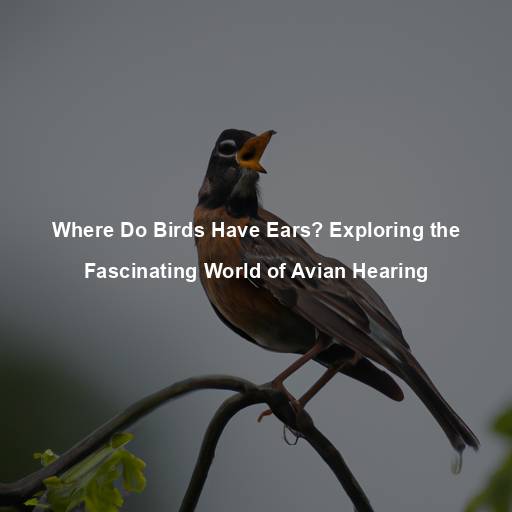How Do Birds Hear?
Last Updated on November 16, 2023 by Evan
Birds, those mesmerizing creatures that hold us spellbound with their beautiful melodies and enchanting aerial displays, are more than meets the eye. Have you ever pondered on the captivating way they navigate and make sense of their surroundings? It is their extraordinary sense of hearing that sets them apart from the rest of the animal kingdom. Together, let us embark on a journey to unravel the mysteries of avian auditory systems and uncover the enigmatic mechanisms that enable birds to perceive sound.
Contents
- 1 Bird Hearing Anatomy
- 2 Avian Hearing Range
- 3 How Do Birds Hear Low-Frequency Sounds?
- 4 How Do Birds Hear High-Frequency Sounds?
- 5 The Role of Birdsong in Communication
- 6 Avian Auditory Adaptations
- 7 The Wonders of Avian Auditory Systems
- 8 FAQs – How do birds hear?
- 8.1 What is the auditory system of birds?
- 8.2 How do birds detect sound?
- 8.3 How does the middle ear of birds work?
- 8.4 What is the role of the inner ear in bird’s hearing?
- 8.5 How do birds perceive different pitches and frequencies of sound?
- 8.6 Can birds hear better than humans?
- 8.7 Do all birds have similar hearing abilities?
- 8.8 How does background noise affect a bird’s ability to hear?
- 8.9 Can birds go deaf?
Bird Hearing Anatomy
To understand how birds hear, we must first examine their auditory anatomy. Like humans and many other animals, birds possess ears that allow them to detect and interpret sound waves. However, their ear structure differs in some unique ways.
External Ear
It’s fascinating how birds have evolved in a unique way, differing from their mammalian counterparts. Unlike mammals, who sport those cute and floppy external ears, birds have a different approach. Instead, they possess this tiny, inconspicuous opening called the external auditory meatus, which connects to their middle ear. This curious adaptation not only adds to their aerodynamic prowess, but it also leaves us in awe of nature’s artistic intricacies.
Middle Ear
Birds have a middle ear that consists of three small, delicate bones known as the ossicles. These bones, namely the stapes, incus, and malleus, transmit sound vibrations from the external auditory meatus to the inner ear. The middle ear in birds is similar to that of mammals, with the ossicles amplifying sound signals.
Inner Ear
In the ethereal world of avian anatomy, lies a mysterious chamber known as the cochlea. This enigmatic enclave, nestled deep within the inner ear, possesses an uncanny ability to transmute ethereal vibrations into enigmatic electrical whispers that captivate the avian mind. Within its hallowed boundaries, a legion of minuscule hair cells stand poised, akin to sensory sentinels, awaiting their fateful task of unraveling the secrets of sound. As these cryptic receptors immerse themselves in the symphony of auditory stimuli, the intricacies of avian perception unfold, leaving us in a perpetual state of awe and perplexity.
Avian Hearing Range
Birds possess an extraordinary knack for detecting an extensive array of frequencies, going beyond the audible spectrum of human ears. While most humans can perceive sounds between 20 Hz and 20,000 Hz, the avian world marvelously surpasses this limit by honing in on frequencies spanning from approximately 1,000 Hz to 4,000 Hz. This enhanced auditory range grants our feathered friends the ability to engage in a complex symphony of melodious songs and captivating calls, creating a tapestry of communication that defies our understanding.
How Do Birds Hear Low-Frequency Sounds?
The astonishing prowess of birds’ hearing in the realm of low-frequency sounds remains an enigmatic marvel. Intriguingly, this auditory prowess is not only crucial for their very existence but also empowers them to discern distant rumblings and perceive the stealthy presence of potential adversaries. The intricate mechanisms and bewildering adaptations that underlie this remarkable auditory feat continue to baffle scientists, leaving us captivated by the intricate symphony of nature.
Head Movements
Birds possess a remarkable capacity for augmenting their ability to perceive low-frequency sounds, employing the strategic utilization of head movements. Through skillfully positioning their heads at precise angles, they adeptly capture and intensify these auditory frequencies. The pinnacle masters of this extraordinary behavior are none other than the enigmatic owls, possessing the uncanny flexibility to rotate their heads up to a confounding 270 degrees, a true marvel of the avian world!
Specialized Inner Ear Structures
Birds’ inner ears also play a crucial role in their low-frequency hearing abilities. The basilar papilla, a structure within the cochlea, is responsible for detecting low-frequency sounds. This specialized organ allows birds to perceive low-pitched calls and identify potential threats or food sources.
How Do Birds Hear High-Frequency Sounds?
Birds possess a remarkable capacity for discerning both low-frequency and high-frequency sounds, a skill critical for those reliant on complex vocalizations and melodic songs. Their sensory acuity extends to both ends of the auditory spectrum, making them exceptional auditory creatures. This remarkable ability adds to the bewildering array of talents these feathered creatures possess, leaving us in awe of their exquisite auditory perception.
Hair Cells
High-frequency sounds are detected by hair cells in the inner ear. These hair cells respond to different frequencies depending on their location within the cochlea. The basilar papilla, which detects low frequencies, gradually transitions into the tectorial membrane, which is responsible for high-frequency perception.
Song Learning
In the world of avian melody, where intricate harmonies and lyrical riffs abound, a captivating phenomenon emerges. Birds, masters of sound and imitation, possess an extraordinary gift – the capacity to hear and replicate the most ethereal of high-frequency tunes. Through a captivating process known as song learning, the fledglings of these avian virtuosos hone their craft by finely tuning into the vocalizations of their experienced counterparts, skillfully mimicking their every note and inflection. This symphony of auditory prowess and flawlessly discerning senses allows these feathered maestros to showcase their ability to capture the most delicate cadences and intricate melodies, leaving us in awe of their melodious virtuosity.
The Role of Birdsong in Communication
From the rich tapestry of nature’s symphony, the melodic artistry of birdsong captivates our senses, whispering untamed secrets through delicate notes and harmonious trills. Beyond its ethereal beauty, this primal language is a lifeline for our feathered friends. In the realm of avian existence, it weaves a mesmerizing web, binding courtship dances, marking territorial borders, and unraveling the enigma of identity. Within each nuanced cadence lies a world of communication, a vibrant tapestry of survival and connection.
Courtship and Mating
When it comes to wooing their potential partners, male birds really know how to put on a show! They use their melodic voices to create the most mesmerizing tunes, signaling their strength and good genes to the ladies. The more intricate and captivating the song, the better their chances of finding a feathered soulmate. So next time you hear those sweet melodies in the great outdoors, just remember that it’s all part of the avian dating game.
Territorial Defense
The avian world is a melodious marvel filled with perplexing melodies and captivating choruses. Through their ethereal songs that reverberate through the air, birds establish their dominion and ward off unwanted trespassers. This melodic tapestry serves as a harmonious beacon, safeguarding their territorial sanctuary from interlopers and ensuring a bountiful haven for nurturing their precious fledglings.
Individual Recognition
Birdsong, mesmerizing and enigmatic, holds within it the key to individual identification. Within the vast symphony of nature, each bird species boasts its own melodic repertoire, a secret language spoken only among its kind. Through the intricate tapestry of harmonies, these feathered creatures weave connections, recognizing and responding to the familiar strains that resonate deep within their souls. In this ethereal realm, bonds are forged, alliances are forged, and the very essence of cooperation takes flight.
Avian Auditory Adaptations
Throughout the course of evolutionary history, birds have undergone incredible transformations to sharpen their auditory senses, enabling them to navigate their surroundings with unparalleled precision. These astounding adaptations have paved the way for a fascinating array of avian auditory abilities tailored to suit their specialized environments and ecological roles. From lush rainforests to bustling city streets, these feathered creatures have developed an astonishing repertoire of auditory adaptations that truly showcase the wonders of nature’s ingenuity. Witness firsthand the awe-inspiring diversity of avian hearing as we delve into the intricate world of these sonic marvels.
Nocturnal Adaptations
In the mystical realm of the avian world, there exists a curious bunch of creatures with a knack for thriving under the cloak of darkness. Meet the owls and nightjars, the enigmatic beings that possess a set of extraordinary skills tailored specifically for the low-light dance of survival. These birds, with their finely tuned auditory systems, can discern even the faintest of whispers and skillfully locate their unsuspecting prey amidst the deep shadows of the night. Such is the extent of their reliance on their acute hearing that it becomes an integral part of their nocturnal existence.
Underwater Hearing
Did you know that some birds, like ducks and diving birds, actually have a remarkable ability to hear underwater? It’s true! These feathered creatures possess a specialized middle ear structure that allows them to pick up and interpret sounds even while submerged. This incredible adaptation comes in handy when they’re on the hunt for a tasty meal beneath the water’s surface.
Directional Hearing
Birds possess an incredible gift of acute directional hearing, enabling them to effortlessly locate the origin of sounds with remarkable precision. Through astutely analyzing the subtle disparities in timing and intensity as sounds travel to each ear, these feathered creatures adeptly discern the exact direction from which a sound emanates. This remarkable skill proves especially advantageous when it comes to identifying potential prey or detecting lurking predators in their environment.
The Wonders of Avian Auditory Systems
The world of bird hearing is a fascinating realm full of complexity and wonder. These feathered creatures possess a truly remarkable auditory system that allows them to tune into an array of frequencies that span from earthy rumbles to celestial melodies. Such a skill grants them the ability to seamlessly navigate their surroundings, communicate with their avian brethren, and thrive in a multitude of ecosystems. As we delve further into the mysterious world of avian hearing, we can’t help but marvel at the intricacies of these extraordinary beings and the extraordinary sensory journeys they embark upon.
Get ready to dive deep into the mysterious realm of avian auditory cognition as we unravel the intricate connections between birds’ sense of hearing and their fascinating behaviors. From the melodies of their calls to the nuanced cues they pick up from the environment, we will explore how birds navigate their world through sound. Stay tuned for an awe-inspiring journey into the captivating world of bird communication and the mesmerizing stories waiting to be unveiled!
Birds’ sense of hearing not only allows them to perceive the world around them but also plays a significant role in shaping their behavior and interactions with the environment. In this section, we will delve into how avian auditory abilities influence various aspects of bird behavior.
Vocalizations and Communication
In the avian world, the art of communication takes flight through a symphony of intricate songs and calls, captivating the attention of both their kind and others. The melodic tapestry weaves a web of messages, as birds harness their exceptional hearing prowess to transmit meaning in ways that baffle and amaze us. Through their vocal prowess, these feathered messengers bridge the gap between species, leaving us in perpetual awe of their mysterious linguistic talents.
Songbird Communication
Songbirds are renowned for their complex and melodious songs, which serve various purposes. Male songbirds use their songs to establish and defend territories, attract mates, and communicate with rivals. Their songs often contain intricate patterns and sequences, showcasing their vocal prowess and genetic fitness.
Alarm Calls
In the fascinating world of avian communication, birds have developed a remarkable skill that leaves us in awe — their ability to produce alarm calls. These vocal warnings serve as a vital means of alerting their fellow feathered friends about potential dangers lurking in the vicinity. Through a delightful blend of ingenuity, birds have crafted specialized calls tailored to different types of threats, ensuring that their conspecifics can react in just the right way. Whether it’s the grounded predators or those soaring through the skies, our feathered friends have found a baffling variety of vocal codes to communicate it all.
Birds’ keen sense of hearing aids them in navigation and orientation, particularly during long-distance migrations and territorial movements. They rely on natural sounds and environmental cues to navigate their surroundings accurately.
It never fails to astonish me how birds, with their delicate bodies and seemingly simple minds, are able to navigate vast distances using nothing but the sun and stars as their compass. It’s like they have some secret code embedded in their DNA that allows them to interpret the subtle variations in sunlight and make course corrections effortlessly. Every time I think I’ve figured out their mystical ways, they manage to surprise me again with their keen sense of direction and unwavering determination to reach their final destination.
Acoustic Landmarks
Birds also use acoustic landmarks, such as the sounds of rivers, streams, or other distinct natural features, to orient themselves spatially. By recognizing and memorizing these auditory cues, they can navigate complex landscapes with precision.
Foraging and Prey Detection
Imagine the mastery of our feathered friends as they harness their incredible auditory prowess to skillfully track down and seize their next meal. With an uncanny sense for sound, these avian hunters rely on intricate audio cues to detect even the faintest signs of motion and pinpoint potential sources of sustenance, conquering even the most formidable of habitats. It is a testament to their remarkable adaptability, navigating through a world filled with endless auditory challenges, that they demonstrate the true essence of the phrase “hunting by ear”.
Insectivorous Birds
In the enchanting realm of avian wonders, there exists a magnificent group of birds that rely on their auditory prowess to hunt down the melodic whispers of airborne insects. With their keen sense of hearing finely tuned to the symphony of high-frequency sounds produced by their tiny prey, these feathered masters of deception possess an extraordinary ability to pinpoint the precise location of an insect’s ethereal buzz or fluttering wingbeats. And so, with a bewitching display of dexterity and unwavering precision, these avian virtuosos execute breathtaking aerial maneuvers to effortlessly capture their unsuspecting victims, leaving us in awe of their perplexing talents.
Underwater Foragers
Certain bird species, such as diving ducks and seabirds, have adapted to forage underwater. They use their exceptional underwater hearing to detect the sounds made by fish or other aquatic prey. This auditory prowess allows them to navigate beneath the water’s surface and secure their meals.
Social Interactions and Mate Selection
The melodious world of birds is intricately interwoven with the power of their hearing, painting a tapestry of social bonds, passionate courtships, and intricate pecking orders among these feathered creatures. The symphony of their songs reverberates across the avian realm, orchestrating an intricate dance of communication and connection. From the graceful melodies that bind mates together to the harmonious calls that establish avian hierarchies, the magical realm of bird communication through sound is a testament to the mysterious realms of nature.
Courtship Rituals
Male birds often use elaborate songs and calls to attract potential mates and establish their desirability. Females assess the quality of a male’s vocalizations, as they can be indicative of genetic fitness and overall health. The ability to produce complex and well-coordinated songs is often seen as an attractive trait.
Vocal Mimicry
Some bird species, such as parrots and starlings, possess the remarkable ability to mimic various sounds and even human speech. This vocal mimicry is primarily achieved through their exceptional hearing and the ability to accurately reproduce sounds they have heard.
Adaptations for Hearing in Different Habitats
Birds have evolved specific adaptations to enhance their hearing abilities in different habitats and ecological niches. These adaptations allow them to thrive in diverse environments and fulfill their unique ecological roles.
Forest Dwellers
In the depths of vibrant forests, where foliage weaves an intricate tapestry and a symphony of creatures fills the air, birds emerge as masters of deciphering a bewildering soundscape. With an astonishing repertoire of adaptations, they navigate this auditory labyrinth with finesse and grace. Some possess an uncanny ability to capture even the faintest whispers from afar, while others boast intricate ear structures that act as sentinels, shielding them from the commotion that surrounds them. It is in these magical woodland realms where the birds’ enigmatic powers of perception truly come to life.
Open Habitat Specialists
Bird species that inhabit open habitats, such as grasslands or deserts, may have adaptations that allow them to detect sounds over long distances. Their auditory systems may be finely tuned to perceive high-frequency sounds, which can carry over vast open spaces.
The Intricacies of Avian Auditory Systems
Birds’ hearing abilities are a testament to the wonders of evolution and adaptation. Their remarkable auditory systems, from the absence of external ears to the intricate structures within the inner ear, enable them to perceive and interpret a broad range of sounds.
Environmental Influences
Birds’ hearing can be influenced by various environmental factors, including ambient noise levels, habitat characteristics, and the presence of other species. These factors shape the specific adaptations and sensitivities of different bird species, allowing them to thrive in their respective niches.
Individual Variability
Just like humans, individual birds may exhibit variability in their hearing abilities. Some individuals may possess more acute hearing, while others may have slight impairments. This variability can be influenced by factors such as age, genetics, and exposure to loud noises or environmental toxins.
The Beauty of Avian Auditory Diversity
The rich diversity of bird species is reflected not only in their appearances and behaviors but also in their auditory capabilities. Each species has its unique vocal repertoire, hearing range, and adaptations, making the avian world a symphony of sounds.
Birdsong as Cultural Heritage
Birdsong has deep cultural significance in many human societies. The beauty and intricacy of bird vocalizations have inspired poets, musicians, and artists throughout history. Birds’ songs are often associated with specific seasons, landscapes, and emotions, contributing to our collective cultural heritage.
Conservation Implications
In our quest to safeguard the feathered wonders of the skies, unlocking the enigmatic realm of avian auditory prowess becomes paramount. As we delve into the intricate complexities of how birds perceive and harness the power of sound, a tapestry of conservation truths unravels before us. Through the lens of research, we gain insight into the invisible perils that lurk, threatening the delicate symphony of avian communication, and by doing so, we wield the tools to forge a brighter future for our avian companions.
FAQs – How do birds hear?
What is the auditory system of birds?
When it comes to birds, their auditory system dances to a similar tune as that of mammals like humans. You see, it’s composed of the outer ear, middle ear, inner ear, and the all-important auditory nerve. But hold on tight, because there are some mind-boggling differences in how these structures are shaped and how they work in our feathered friends compared to us mammals. Prepare to dive into the intriguing world of avian auditory wonders!
How do birds detect sound?
Birds detect sound through their highly developed sense of hearing. Sound waves first enter their outer ear, which includes the visible ear opening known as the ear canal. From there, the sound waves travel through the external auditory canal to reach the middle ear.
How does the middle ear of birds work?
Discover the intriguing world of avian anatomy as we delve into the astonishing middle ear of birds. Tucked away within this enigmatic soundscape lie three minuscule yet mighty bones known as the ossicles: the hammer, anvil, and stirrup. Unlike their mammalian counterparts, these remarkable avian ossicles are uniquely fastened to the skull, defying convention and enabling an unparalleled auditory experience in our feathered friends. Prepare to be captivated by the perplexing mechanisms that facilitate the seamless transmission of sound vibrations from the eardrum to the inner ear in the avian kingdom.
What is the role of the inner ear in bird’s hearing?
Have you ever wondered how birds are able to effortlessly navigate through the cacophony of the natural world? It’s all thanks to their remarkable inner ear, a complex system that converts sound vibrations into electrical signals that their brains can decipher. At the heart of this intricate mechanism lie two fluid-filled structures known as the cochlea and the semicircular canals, working in perfect harmony to capture every nuanced sound. However, it is the cochlea that takes center stage in the symphony of sound perception, housing a delicate network of hair cells that transform the melodies of the world into electrical whispers that ignite the avian mind. Brimming with mystery and awe, the inner ear of birds remains a puzzling marvel of evolutionary craftsmanship.
How do birds perceive different pitches and frequencies of sound?
Birds have specific areas in their cochlea that are tuned to different frequencies, allowing them to perceive a wide range of pitches and frequencies in their environment. The location within the cochlea where the hair cells are stimulated determines the pitch that the bird perceives.
Can birds hear better than humans?
When it comes to sound, birds are in a league of their own. Their ears possess a remarkable sensitivity that puts us mere humans to shame. These feathered creatures boast an impressive auditory range, picking up frequencies that our ears can only dream of perceiving. And if that wasn’t enough, they can hear whispers from afar, effortlessly capturing distant sounds that elude our limited senses. It’s truly bewildering how nature has gifted birds with such a perplexing auditory prowess.
Do all birds have similar hearing abilities?
Birds possess a wondrous assortment of auditory capabilities, tailored to their unique requirements in the wild. Take birds of prey, for instance – their formidable hearing prowess enables them to pinpoint minuscule prey, stealthily hidden from sight. On the other hand, avian species reliant on vocal exchanges boast extraordinary hearing adaptations, finely attuned to discern and differentiate an array of distinctive sounds. Flighted creatures truly exemplify the diverse and remarkable world of avian audition.
How does background noise affect a bird’s ability to hear?
Background noise, such as the sound of wind, traffic, or other animals, can potentially interfere with a bird’s ability to detect and distinguish sounds. However, birds have remarkable auditory filtering abilities, which help them focus on specific sounds of interest while disregarding irrelevant background noises. This allows them to effectively communicate, navigate, and locate prey, even in noisy environments.
Can birds go deaf?
Yes, birds can experience hearing loss and deafness, much like humans and other animals. Several factors can contribute to hearing loss in birds, including old age, exposure to loud noises, certain diseases or infections, and genetic abnormalities. In some cases, hearing loss can greatly impact a bird’s ability to survive in its natural environment.







